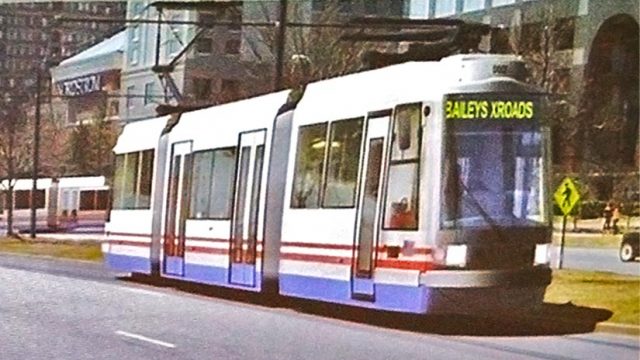Arlington streetcar claim veers off rails before election

STREETCAR DESIRE: A new study pushes the economic benefits of a streetcar project on Columbia Pike, shown in this computer-generated illustration.
By Kenric Ward | Watchdog.org Virginia Bureau
ARLINGTON, Va. — A new study says a 4.7-mile Arlington streetcar line will generate up to $4.4 billion in economic growth.
The source and timing of the report — just days before a key county board election — suggest the prediction is more politics than reality.
Investing $284 million in a trolley system along Columbia Pike would yield $3.2 billion to $4.4 billion in net tax revenue for Arlington and Fairfax counties over the next 30 years, according to HR&A Advisors.
The HR&A study was funded by Arlington County government, which is pushing the streetcar project against growing community opposition.
“This study was timed to come out just 11 days before the special election in Arlington” on April 8, notes Joe Warren, a skeptical member of the county’s Transit Advisory Committee.
DERAIL: Seeking a seat on the County Board, John Vihstadt wants to block the Arlington rail project.
Board candidate John Vihstadt and other critics dismiss the light-rail venture as a politically juiced “vanity” project.
“He who pays the piper calls the tune,” Peter Rousselot told InsideNova. Rousselot is a leader of Arlingtonians for Sensible Transit, which advocates a bulked-up system to shuttle riders along Columbia Pike.
Vihstadt, a member of AST, said streetcars are too expensive and will not meet rosy ridership forecasts. Running as an independent, Vihstadt has garnered support from Republicans, dissident Democrats and the local Green Party.
Vihstadt’s opponent, Democrat Alan Howze, endorses the light-rail line.
Warren said HR&A’s projections are “not credible” because the value of development over 30 years far exceeds that of expanded bus service.
“The low estimate shows over $2 billion more development for the streetcar compared with articulated buses — $3.2 billion compared to $1 billion for the bus. That is literally incredible,” Warren told Watchdog.org.
“No study by the respected Transportation Research Board shows development that much over a comparable (and less costly) bus option,” Warren said.
Nat Bottigheimer, general manager of planning and joint development at Washington Metropolitan Area Transit Authority, said development and land values are “similar” if bus service is comparable to rail.
Capital costs for expanded bus service are forecast to run $67 million. Buses would cost $140 million to operate and maintain over 30 years, compared to $230 million for the streetcars.
Watchdog reported earlier this year the streetcar price tag has more than doubled since county officials and their consultants began pitching the idea in 2005. Critics predict that streetcars will increase — not decrease — road congestion by reducing traffic lanes on Columbia Pike.
Across the Potomac, testing of a streetcar prototype on H Street in Washington, D.C., hasn’t gone well. The test vehicle needed almost an hour to travel five blocks last year.
Kenric Ward is chief of Watchdog.org’s Virginia Bureau. Contact him at kenric@watchdogvirginia.org or at (571) 319-9824. @Kenricward







